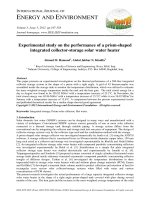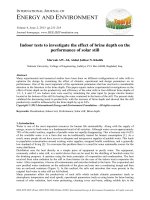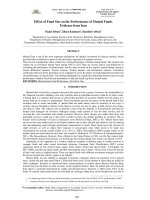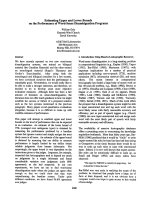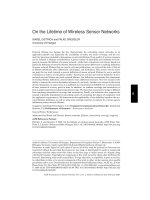On the performance of cooperative cognitive networks with selection combining and proactive relay selection
Bạn đang xem bản rút gọn của tài liệu. Xem và tải ngay bản đầy đủ của tài liệu tại đây (370.31 KB, 10 trang )
TAẽP CH PHAT TRIEN KH&CN, TAP 18, SO K6- 2015
On the performance of cooperative
cognitive networks with selection combining
and proactive relay selection
Ho Van Khuong
Vo Que Son
Luu Thanh Tra
Ho Chi Minh city University of Technology, VNU-HCM, Vietnam
Pham Hong Lien
University of Technical Education, Ho Chi Minh city, Vietnam
(Manuscript Received on July 15, 2015, Manuscript Revised August 30, 2015)
ABSTRACT:
This paper proposes an outage analysis
framework for cooperative cognitive networks
with proactive relay selection and selection
combining (SC) under licensed outage
constraint,
maximum
transmit
power
constraint, independent non-identical (i.n.i)
fading distributions, erroneous channel
information, and licensed users interference.
Towards this end, we firstly suggest power
allocation for unlicensed transmitters to
satisfy power constraints and account for
erroneous channel information and licensed
users interference. Then, we propose an
exact closed-form outage probability formula
for the unlicensed network to promptly
evaluate system performance and provide
useful insights into performance limits.
Multiple results show performance trade-off
between the unlicensed network and the
licensed network, error floor in the unlicensed
network, considerable system performance
degradation owing to erroneous channel
information and licensed users interference,
and significant performance enhancement
due to the increase in the number of relays.
Keywords: Proactive relay selection, erroneous channel information, cognitive radio.
1. INTRODUCTION
Currently, many emerging wireless services
such as high definition video streaming, video
calling, file transferring and high-speed internet
access demand more and more radio spectrum
while the conventional allocation of frequency
bands by means of fixed licensed users (LUs) is
not efficient, causing spectrum shortage. This
shortage conflicts with a severe spectrum underutilization as reported in an extensive survey on
frequency spectrum utilization carried out by the
Federal Communications Commission [1]. A
cognitive radio (CR) technology has been recently
proposed to resolve this contrast [2]. The
philosophy behind this technology is the coexistence of unlicensed users (UUs) and LUs on
the frequency band inherently allotted to the LUs
subject to an acceptable quality of service (QoS)
at LUs. However, the interference from UUs on
LUs becomes a great challenge to the CR
technology. To control this interference, UUs
Trang 29
SCIENCE & TECHNOLOGY DEVELOPMENT, Vol.18, No.K6 - 2015
wisely limit their transmit power to ensure that the
induced interference at LUs remains below a
controllable level, ultimately reducing their
communication
range.
To
extend
the
communication range for UUs, relaying
communications technique should be integrated
into UUs [3]. In relaying communications, relay
selection criteria plays a very important role in
improving system performance in terms of
spectral efficiency, power consumption, and
transmission reliability.
To optimize system design such as optimum
power allocation, channel information is required
to be available. Nevertheless, this information is
inevitably erroneous, inducing the study on the
impact of channel information error on the outage
performance of relay selection criterions in
cooperative cognitive networks to be essential.
The effect of channel information error on the
proactive, reactive, partial relay selection criteria
was investigated in [5], [6], and [4], [7], [8],
respectively. However, [4]–[8] assumed no
licensed users’ interference, independent and
partially-identical fading distributions, and no
licensed outage constraint.
Motivated by the above, this paper proposes
an outage analysis framework for the proactive
relay selection in cooperative cognitive networks
under practical operation conditions such as
maximum transmit power constraint, channel
information error, i.n.i fading distributions,
licensed outage constraint, and licensed users’
interference to evaluate system performance
quickly and to expose performance limits.
The structure of this paper is as follows. The
next section presents the system model under
investigation. Power allocation for UUs is
discussed in Section 3. An exact closed-form
outage probability formula for the unlicensed
network is elaborately derived in Section 4.
Results for validating the proposed formulas and
demonstrating the outage performance of the
Trang 30
proactive relay selection in cooperative cognitive
networks are presented in Section 5. Finally, the
paper is closed with useful remarks in Section 6.
2. SYSTEM MODEL
Figure 1 shows a cooperative cognitive
network with the proactive relay selection where
the best unlicensed relay U R b in the group of J
unlicensed
relays,
R {U R 1 , UR 2 , ..., U R J }
assists communication between the unlicensed
source U S and the unlicensed destination U D .
Independent, frequency-flat, and Rayleighdistributed fading channels are considered and
hence, the channel coefficient, hklp , between the
transmitter k and the receiver l in the phase p can
be modelled as a circular symmetric complex
Gaussian random variable with zero mean and klp
-variance, i.e. h k lp ~ CN (0 , k lp ) , as illustrated
in Table 1.
To support performance analysis in presence
of channel estimation error (CEE), we applied the
well-known CEE model (e.g., [9]) where the
relation between the real channel coefficient,
h k l p , and its estimated one, hˆ k l p , is given by
hˆklp hklp 1 2 klp
(1)
where klp is the CEE and is the correlation
0 1,
coefficient,
characterizing
the
average quality of channel estimation. Similarly
to [9], all random variables { hˆklp , hklp , klp } are
modelled as CN 0, klp .
Figure 1 shows that the proactive relay
selection in cooperative cognitive networks takes
place in two phases. In the phase 1, U S sends the
signal x S with transmit power PS (i.e.,
2
PS ExS { xS } where
E X { x} stands for the
expectation operator over random variable X)
while L T is simultaneously sending the signal x L1
with transmit power PL . The signals from
US
TAẽP CH PHAT TRIEN KH&CN, TAP 18, SO K6- 2015
and L T cause the mutual interference between the
licensed network and the unlicensed network.
Therefore, the received signals at the licensed
receiver L R and the unlicensed receivers (i.e.,
U R j , and U D ), respectively, can be given by
hjL2 ~ CN (0, jL2 ) UR j
(3)
ySl1
where n lp ~ CN (0, N 0 ) is the additive
white Gaussian noise (AWGN) at the
corresponding receivers.
{hLLp}
LR
1 2
hSl1
xS
Sl1 xS
hLl1 xL1 nl1 , l {D , J }
hbL2
{hLj1}
p=1,2
j=1,2,...,J
1 2
hLL1
xL1
LL1xL1 hSL1xS nL1 (4)
2
LL1
UR1
{hLDp}
URb
{hSj1}
1
2
2
P hSL1 2 PS 2 N 0
LL1 L
(6)
hbD2
US
2
UD
Sl1
Unlicensed network
Figure 1. System model
1.
hSl1 PS
hSD1
phase 1
Table
hLL1 PL
phase 2
URJ
hSL1
Notations
for
channel
coefficients:
J {1,...J } .
Notation
hLLp ~ CN 0, LLp
Channel coefficient
between
LT
and L R
in the
phase p
hLj1 ~ CN (0, Lj1)
hLDp ~ CN (0, LDp )
and
LT
UR j ,
jJ
LT
(5)
which result in the signal-to-interference plus
noise ratio (SINR) at the licensed receiver and the
unlicensed receivers in the phase 1 as
Licensed network
LT
L R ,
Using (1) to rewrite (2) and (3) as
yLL1
ySl1 hSl1xS hLl1xL1 nl1, l D,J
and
jJ
(2)
y L L 1 h L L 1 x L 1 h SL 1 x S n L 1
Channel coefficient
between
Notation
and
UD
1
2
2
P 2 hLl1 PL 2 N 0
Sl 1 S
, l {D , J }
(7)
This paper analyzes the outage performance
of the proactive relay selection in cooperative
cognitive networks. According to the proactive
relay selection criterion, the selected relay U R b
is the one that obtains the largest end-to-end
SINR, i.e.
b arg max min Sj1 , jD 2
in the
(8)
jJ
phase p
hSL1 ~ CN (0, SL1)
hSj1 ~ CN (0, Sj1)
USand L R
US and
where jD 2 is the SINR of the signal received at
UD
UR j ,
jJ
hjDp ~ CN (0, jDp ) UR j
and
jJ
hSD1 ~ CN (0, SD1) USand UD
UD ,
from U R
j
in the phase 2. This signal can be
represented in the same form as (5), i.e.
y jD 2
h jD 2
1 2
jD 2 x j
hLD 2 xL 2 nD 2
xj
(9)
where j J , xL2 is the signal transmitted by L T
with the power PL, and xj is the signal transmitted
Trang 31
SCIENCE & TECHNOLOGY DEVELOPMENT, Vol.18, No.K6 - 2015
by U R
j
with the power Pj . As such, jD 2 can be
computed in the same way as (7), i.e.
maximum transmit powers (i.e., PSm and Pbm).
Therefore, the transmit powers of US and U R b
2
jD 2
hˆ jD 2 Pj
1
2
2
jD 2
Pj 2 hLD 2 PL 2 N 0
(10)
In the phase 2, L R also receives the desired
signal from L T and the inference signal from
U R b . Therefore, the SINR at L R in the phase 2
can be expressed in the same form as (6), i.e.
2
LL 2
hˆLL 2 PL
1
2
(11)
2
2 Pb 2 N 0
LL 2 PL hbL 2
To recover the source information with low
implementation complexity, both signals received
from US and U R b can be selection-combined at
UD , which results in the total SINR at UD
Moreover, unlicensed transmitters (i.e., US
and U R b are constrained by their designed
tot max SD1 , max min Sj1 , jD 2
jJ
as
are also upper-bounded by PSm and Pbm,
respectively, i.e.
(15)
PS PSm
Pb Pbm
(16)
Theorem: For the maximum transmission
range, the transmit power of a unlicensed user
that satisfies both the licensed outage constraint
and the maximum transmit power constraint is
given by
1
PL LLp 1
Pk min
1 , Pkm
2
2
N
2
L kLp L 1 PLLLp0
e
L
(17)
(12)
FOR
where [x]+ denotes max(x, 0) and the phase 1
corresponds to (k, p) = (S, 1) while the phase 2
corresponds to (k, p) = (b, 2).
To guarantee QoS for LUs [10], the power of
unlicensed transmitters must be properly allocated
to meet the licensed outage constraint. To this
effect, the transmit powers of US and U R b must
Proof: The proof for (k, p) = (S, 1) is
presented, which is straightforwardly extended to
(k, p) = (b, 2) for completing the whole proof of
Theorem.
3.
POWER
ALLOCATION
UNLICENSED USERS
be limited to satisfy the following two licensed
outage constraints, correspondingly:
Prlog2 1LL1 L FLL1 (L )
(13)
Prlog2 1LL2 L FLL2 (L )
(14)
where Pr{X} stands for the probability of the
event X, L 2 1 with L being the required
L
transmission rate in the licensed network, FX(x)
signifies the cumulative distribution function
(cdf) of X, and is the required outage probability
of LUs.
Trang 32
Let
2
X hˆLL1 PL
and
2
Y 1 2 LL1PL hSL1 2 PS 2 N 0 .
Since
hˆLL1 ~ CN 0, LL1
hSL1 ~ CN 0, SL1 ,
the
and
probability density
function (pdf) of X and the pdf of Y,
correspondingly are given by
x
1
f X x
e PL LL1 , x 0
PLLL1
(18)
TAẽP CH PHAT TRIEN KH&CN, TAP 18, SO K6- 2015
x u
fY x
2
1
e PS SL1 , x u
2
PS SL1
where u 1
2
4. OUTAGE ANALYSIS
(19)
P 2 N0 .
LL1 L
Given LL 1 X / Y in (6), it immediately
follows that
This section presents a formula of outage
probability, which is defined as the probability
that the total SINR is below a predefined 1
threshold S, i.e.
OP Pr tot S
Pr max SD1 , max min Sj1 , jD 2
L y
F LL 1 L f X x dx fY y dy
u
0
(20)
F L L 1 L 1
FLL1 L
Pr SD1 S
M1
as
PL LL 1 e L L L 1
PL LL 1 L 2 PS SL 1
S
Substituting (18) and (19) into (20) and
performing simplifications, one obtains the
closed-form expression of
jJ
(25)
Pr max min Sj 1 , jD 2 S
jJ
(21)
M2
Before presenting closed-form expressions of
M 1 and M 2 for completing the analytic evaluation
where LL 1 1 2 2 N 0 / PL L L 1 .
Using (21), we deduce PS that meets (13) as
PL LL1 e LLL1
PS
1
2
L SL1 1
(22)
When e 1, the right-hand side of
L LL1
(22) becomes negative. As such, the constraint in
(13) is equivalent to
e LLL1
P
PS L 2 LL1
1
L SL1 1
(23)
Finally, combining (23) with (15) results in
P
e L LL 1
L LL 1
PS min
1 , PSm
2
L SL1 1
F Sl 1 x 1
G Sl 1
e Sl1 x , x 0
x G Sl 1
where
(26)
and
G S l 1 PS S l 1 / 2 PL Ll 1
S l 1 1 N 0 / PS S l 1 .
2
2
It is seen that M
1
is the cdf of
SD 1
evaluated at S, i.e.
M 1 FSD1 S
We rewrite M
(24)
To maximize the communication range, the
equality in (24) must hold, and hence, PS is
reduced to (17) for (k, p) = (S, 1), completing the
proof.
1
of (25), we introduce the cdf of S l 1 where
l { D , J } . Similarly to (21), one obtains the cdf
of Sl1 as
M 2 Eh
LD 2
2
2
(27)
in (25) as
Prmaxmin ,
S hLD2
jJ
2
Sj1
jD2
Due to the two-phase nature of the proactive relay selection,
S is related to the required transmission rate, S, in the
unlicensed network as S 2 2 S 1 .
Trang 33
SCIENCE & TECHNOLOGY DEVELOPMENT, Vol.18, No.K6 - 2015
Eh
2
LD 2
Pr min Sj1 , jD 2
jJ
2
S hLD 2
Eh
2
LD 2
To complete the derivation of the exact
closed-form representation of
(28)
1 Q j T j
jJ
P r
j
T j Pr
S j1
jD 2
S
1 F
2
S hL D 2
Sj1
S
(29)
2 PL
2
S jD 2
hLD 2
jD 2 Pj
C E h 2 Q j e
LD 2
j
C
(36)
2
2
hLD 2 S PL
P
S jD 2
jC jD 2 j
E h 2 e
Q j e
LD 2
jC
hLD2
Using (10) to compute T j in (30) as
2 PL
2
S jD 2
hLD 2
jD 2 P j
(32)
jJ
u
wi wi 1 1 jK
J w , J w , .. ., J
1
jC
2
jC jD 2 Pj
2
2
w i , to
Plugging (37) into (34) and then, inserting the
result together with (27) into (25), one obtains the
exact closed-form representation of OP.
5. ILLUSTRATIVE RESULTS
J i 1 J i 2
J
w1 1 w2 w1 1
K
wi wi 1 1
(34)
CKJ
, and
J j is the value of the j
Trang 34
S jD 2
(37)
th
This section presents various results with
5
arbitrary fading powers as jD 2 11.775 7 ,
j 1
11.6284,5.0188,11.9693,9.2398 ,
LD1 LD 2
C Eh 2 Q j Tj
LD 2
jC
2
2
jD 2 Pj e x / LD 2
jC
dx Q j e S jD 2
LD 2
jC
j
J
where
jD 2
jC
1 S LD 2 PL
(33)
M 2 1 1 J
i 1
x S PL
e
j
expand the product in (28), one obtains
i
0
x dx Q j e
S
2
J
w1 1 w2 w1 1
1
fh
LD 2
jJ
J i 1 J i 2
K
jC
j
j
where
/ LD2 , x 0 .
2
jD 2 Pj
Q e
1 u 1 1 u
i 1
C e
0
J
x S PL
Using the fact that
1
x e x /
LD 2
2
LD 2
the pdf of
Using this fact in (36), one then obtains
2 N0
jD2 1 2
jD2 Pj
i
fh
is
(31)
where Pj has the same form as (17) with
changing k to j and
J 1
2
J 1
hLD2 ~ CN 0, LD2 ,
Since
(30)
Tj e
2 , we firstly
substitute (31) into (35):
where
Q
M
(35)
element in the
J
set.
5
jL 2
j 1
0.6905 ,
3.5696,1.6902,
TAẽP CH PHAT TRIEN KH&CN, TAP 18, SO K6- 2015
4.1890, 5.3979, 3.6321 ,
LL1 LL 2
14.2668,
5
Lj 1
1.7106, 0.9601, 2.5613,
j 1
2.1784, 1.8496 ,
5
Sj1
j 1
= 16 dB. It is observed that the analysis perfectly
matches the simulation. Additionally, the system
performance is significantly better with larger
number of relays. Moreover, some interesting
comments are observed as follows:
The high QoS (e.g., 0.025 in Figure 3)
requirement in the licensed network causes
the unlicensed network to be complete in
outage.
5.5479, 4.6852,
11.8926, 4.6987, 6.7476 ,
SL 1 1.2761 ,
Pkm Pm, k {S, J };
SD1 1 ;
L = 0.5
When the licensed network requires the
moderate QoS (e.g., 0.025 < 0.08 in
Figure 3), the outage performance of the
unlicensed network is drastically improved
with the increase in .
When the licensed network is not stringent
in the QoS (i.e., low QoS requirement), the
unlicensed network suffers error floor for
large values of (e.g., > 0.08 in Figure 3).
bits/s/Hz and S = 0.2 bits/s/Hz. In the sequel,
three different relay sets ({ U R 1 } ,
are illustrated for J = 1, 3, 5,
correspondingly.
Figure 2 illustrates OP with respect to the
variation of for PL/N0 = 16 dB, Pm/N0 = 14 dB,
= 0.05. It is observed that the simulation and the
analysis are in a perfect agreement. Also, the
unlicensed network is complete in outage for a
wide range of (e.g., < 0.935 in Figure 2).
When the channel estimation is better (e.g.,
0.935 in Figure 2), the outage performance of the
unlicensed network is dramatically enhanced.
Moreover, the increase in the number of relays
significantly improves the outage performance.
This comes from the fact that the larger J, the
higher chance to select the best relay, and hence,
the smaller the outage probability.
10
Outage probability
10
10
10
10
10
10
10
10
0
-1
-2
-3
-4
0.01
Sim.:
Ana.:
Sim.:
Ana.:
Sim.:
Ana.:
0.02
J=1
J=1
J=3
J=3
J=5
J=5
0.03
0.04
0.05
0.06
0.07
0.08
0.09
0.1
0.11
Figure 3. Outage probability versus
0
-1
-2
Sim.:
Ana.:
Sim.:
Ana.:
Sim.:
Ana.:
-3
J=1
J=1
J=3
J=3
J=5
J=5
-4
0.9
10
Outage probability
{URj }5j1)
{URj}3j1 ,
0.91
0.92
0.93
0.94
0.95
0.96
0.97
0.98
0.99
1
Figure 2. Outage probability versus
Figure 3 demonstrates OP with respect to the
variation of for Pm/N0 = 14 dB, = 0.97, PL/N0
The results in Figure 3 demonstrate that better
performance of the licensed network (i.e., lower
values of ) induces worse performance of the
unlicensed network (i.e., larger values of OP) and
vice versa. Therefore, the performance trade-off
between the unlicensed network and the licensed
network should be accounted when designing
cooperative cognitive networks.
Figure 4 illustrates OP with respect to the
variation of PL/N0 for Pm/N0 = 14 dB, = 0.97, and
= 0.05. Results expose a perfect agreement
Trang 35
SCIENCE & TECHNOLOGY DEVELOPMENT, Vol.18, No.K6 - 2015
For large values of PL (e.g., PL/N0 > 15 dB
in Figure 4), the L term in (17) is larger
than Pm and hence, the transmit power of
unlicensed users is fixed at the value of Pm
(e.g., Pm/N0 = 14 dB in Figure 4).
Meanwhile, as PL is large and increases, the
interference that the licensed network
imposes on the unlicensed network
dramatically
increases,
ultimately
deteriorating the performance of the
unlicensed network (i.e., increasing the
outage probability). At the very large values
of PL (e.g., PL/N0 37 dB in Figure 4), the
unlicensed network is complete in outage.
Trang 36
-1
10
Outage probability
For small values of PL (e.g., PL/N0 15 dB
in Figure 4), the increase in PL substantially
enhances the outage performance. This can
be interpreted as follows. According to (17),
PL is proportional to L while the power of
unlicensed transmitters is controlled by the
minimum of L and Pm, and hence, at small
values of PL and the fixed value of Pm, the
power of unlicensed transmitters is
proportional to PL, ultimately improving the
performance of the unlicensed network as PL
increases and the interference caused by the
licensed network to the unlicensed network
is not significant (due to small PL).
0
10
Sim.:
Ana.:
Sim.:
Ana.:
Sim.:
Ana.:
-2
10
-3
10
J=1
J=1
J=3
J=3
J=5
J=5
-4
10
0
5
10
15
20
25
PL/N0 (dB)
30
35
40
45
Figure 4. Outage probability versus PL/N0
0
10
-1
10
Outage probability
between the analysis and the simulation.
Additionally, the outage performance is
significantly enhanced with larger number of
relays as expected. Moreover, some interesting
comments are observed as follows:
-2
10
Sim.: J=1
Ana.:
Sim.:
Ana.:
Sim.:
Ana.:
-3
10
J=1
J=3
J=3
J=5
J=5
-4
10
0
2
4
6
8
P m/N0 (dB)
10
12
14
16
Figure 5. Outage probability versus Pm/N0
Figure 5 demonstrates OP with respect to the
variation of Pm/N0 for PL/N0 = 16 dB, = 0.05,
and = 0.97. It is seen that the analysis and the
simulation are in a perfect agreement. Also, the
increase in J dramatically enhances the system
performance.
Furthermore,
the
system
performance is significantly improved with the
increase in Pm. This can be interpreted as follows.
Since Pm upper bounds the power of unlicensed
transmitters (e.g., (17)) and hence, the larger Pm,
the larger the transmit power, ultimately
remedying the corresponding outage probability.
Nevertheless, the unlicensed network experiences
performance saturation at large values of Pm/N0
(e.g., Pm/N0 15 dB in Figure 5). This comes from
the fact that the power of unlicensed transmitters
in (17) is controlled by the minimum of Pm and PL
and hence, as Pm is larger than a certain level (e.g.,
Pm/N0 15 dB in Figure 5), the power of
unlicensed transmitters is completely determined
TAẽP CH PHAT TRIEN KH&CN, TAP 18, SO K6- 2015
by PL, making the outage performance unchanged
regardless of any increase in Pm. However, the
error floor level is drastically reduced with respect
to the increase in J.
6. CONCLUSION
This paper analyzes the outage performance
of cooperative cognitive networks with the
proactive relay selection and the selection
combining under channel information error,
licensed users interference, i.n.i fading channels,
licensed outage constraint and maximum transmit
power constraint. To meet these power constraints
and account for channel information error and
licensed users interference, we proposed an
appropriate power allocation scheme for
unlicensed users. Then, to analytically assess the
system performance in key operation parameters
without exhaustive simulations, we suggested an
exact closed-form outage probability formula.
Various results demonstrate that i) mutual
interference between the licensed network and the
unlicensed network establishes a performance
trade-off between them; ii) channel information
error dramatically degrades system performance;
iii) the unlicensed network suffers the error floor;
iv) the relay selection plays an important role in
system performance improvement as well as
system resource savings.
ACKNOWLEDGEMENT
This research is funded by Vietnam National
Foundation for Science and Technology
Development (NAFOSTED) under grant number
102.04-2014.42.
Hiu nng ca mng nhn thc hp tỏc cú
chn la relay ch ng v kt hp chn
lc
H Vn Khng
Vừ Qu Sn
Lu Thanh Tr
Trng i hc Bỏch Khoa HQG-HCM, Vit Nam
Phm Hng Liờn
i hc S phm K Thut, TP. H Chớ Minh, Vit Nam
TểM TT
Bi bỏo ny xut mt khung phõn tớch
xỏc sut dng cho mng nhn thc hp tỏc
cú chn la relay ch ng v kt hp chn
lc di rng buc xỏc sut dng s cp,
rng buc cụng sut phỏt ti a, phõn b
fading khụng ng nht, thụng tin kờnh
Trang 37
SCIENCE & TECHNOLOGY DEVELOPMENT, Vol.18, No.K6 - 2015
truyền sai, và can nhiễu của người dùng sơ
cung cấp các hiểu biết hữu ích về giới hạn
cấp. Hướng đến mục tiêu này, trước hết
hiệu năng. Nhiều kết quả cho thấy sự tương
chúng tôi đề xuất phân bổ công suất cho các
nhượng hiệu năng giữa mạng sơ cấp và
máy phát thứ cấp để đảm bảo các ràng buộc
mạng thứ cấp, nền lỗi trong mạng thứ cấp, sự
công suất và tính đến thông tin kênh truyền
suy giảm hiệu năng hệ thống đáng kể do
sai và can nhiễu của người dùng sơ cấp. Sau
thông tin kênh truyền sai và can nhiễu của
đó, chúng tôi đề xuất một biểu thức xác suất
người dùng sơ cấp, và sự cải thiện hiệu năng
đáng kể do sự gia tăng về số lượng relay.
dừng chính xác dạng kín cho mạng thứ cấp
để đánh giá nhanh hiệu năng hệ thống và
Từ khóa: Chọn lựa relay chủ động, Thông tin kênh truyền sai, Cognitive radio.
REFERENCES
[1]. FCC, Spectrum policy task force report, ET
Docket 02-135 (2002).
[2]. Goldsmith, S. A. Jafar, I. Maric, and S.
Srinivasa, Breaking spectrum gridlock with
cognitive radios: An information theoretic
perspective, Proceedings of the IEEE, vol.
97, pp. 894-914 (2009).
[3]. J. N. Laneman, D. N. C. Tse, and G. W.
Wornell, Cooperative diversity in wireless
networks: Efficient protocols and outage
behavior, IEEE Trans. Inf. Theory, vol. 50,
pp. 3062-3080 (2004).
[4]. N. H. Giang, V. N. Q. Bao, and H. N. Le,
Cognitive underlay communications with
imperfect CSI: network design and
performance analysis, in Proc. IEEE ATC,
HoChiMinh City, Vietnam, pp. 18-22, 2013.
[5]. H. Ding, J. Ge, D. B. da Costa, and Z. Jiang,
Asymptotic analysis of cooperative diversity
systems with relay selection in a spectrumsharing scenario, IEEE Trans. Veh. Tech.,
vol. 60, pp. 457-472 (2011).
[6]. X. Zhang, J. Xing, Z. Yan, Y. Gao, and W.
Wang, Outage performance study of
Trang 38
cognitive relay networks with imperfect
channel knowledge, IEEE Commu. Lett.,
vol. 17, pp. 27-30 (2013).
[7]. T. L. Thanh, V. N. Q. Bao, and B. An, On the
performance of outage probability in
underlay cognitive radio with imperfect CSI,
in Proc. IEEE ATC, HoChiMinh City,
Vietnam, pp. 125-130 (2013).
[8]. Q. Wu, Z. Zhang, and J. Wang, Outage
analysis of cognitive relay networks with
relay selection under imperfect CSI
environment, IEEE Commun. Lett., vol 17,
pp. 1297-1300 (2013).
[9]. H. A. Suraweera, P. J. Smith, and M. Shafi,
Capacity limits and performance analysis of
cognitive radio with imperfect channel
knowledge, IEEE Trans. Veh. Tech., vol. 59,
pp. 1811-1822 (2010).
[10]. K. Tourki, K. A. Qaraqe, and M. S. Alouini,
Outage analysis for underlay cognitive
networks using incremental regenerative
relaying, IEEE Trans. Veh. Tech., vol. 62,
pp. 721-734 (2013).

